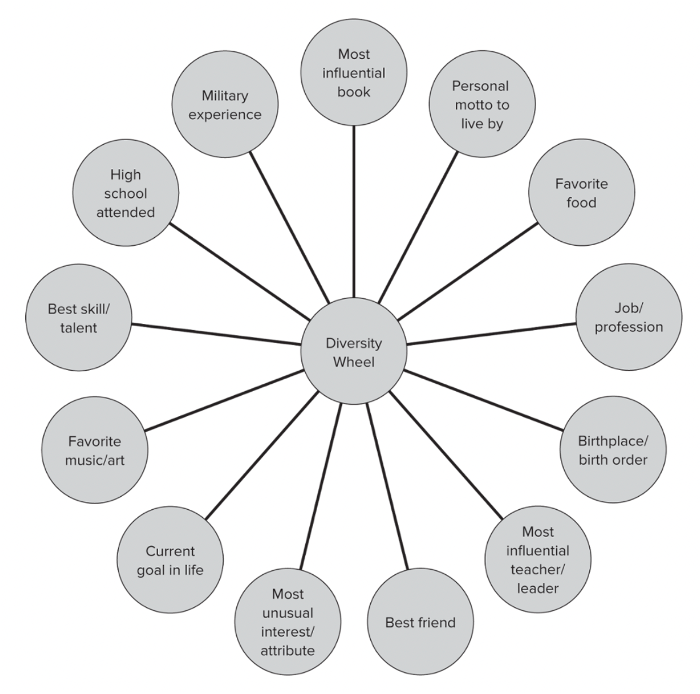Leading Across Generations
One important dimension of diversity is age difference. For the first time in history, five generations of employees are in the workplace.

Veterans, Baby Boomers, and Generations X, Y, and Z share workspaces and projects. The percentage of U.S. workers who are 60 years or older is growing as people remain in the workforce significantly longer than previous generations. 17.3% of Americans are over the age of 65, and 49% of Americans plan to work past 65. Motivations include financial need, sense of purpose, mental stimulation, and social engagement.1
Researchers Freya Owen and Andy Patterson report that the majority of the global workforce is made up of Generation X and Generation Y (also known as Millennials). The proportion of the workforce made up of Generation Z is increasing. Generation Y and Generation Z will make up around 60 percent of the global workforce by 2030.2
Leading, following, and working across generations are challenges for people of all ages. It is difficult for older people to realize this about younger people: They do not know what Sputnik is; Tiananmen Square means nothing to them; and they don’t remember the 1960s, let alone the 1950s. It is difficult for younger people to realize this about older people: They grew up before MTV, AIDS, the microwave, the Internet, Skype, Zoom, and the iPod and iPad.
It’s easy to overlook age differences and realize you may need to speak differently to a group of teenagers than to an audience of senior citizens, even on the same subject. It’s important to hear and see what is said and done from others’ perspectives. Various researchers have identified historic events, technological changes, and economic conditions that have shaped the perspectives of different generations. They attribute misunderstanding and communication challenges between older and younger people to the fact that their attitudes were formed during different social and cultural conditions.
Many labels and time periods have been used to identify employees across generational cohorts since management author and speaker Morris Massey produced his influential and helpful video series in 1970, What You Are Is Where You Were When, designed to bridge the gap between people of different ages. Today’s cohorts and their different attitudes and expectations are:3
1. Veterans, born approximately between 1922 and 1945 (older than 78 years*), value stability and traditional work and family values. They tend to be fiscally and socially conservative. Respect and honor are important to them. They came of age during the Great Depression, World War II and the Korean War and represent a treasure of experience and wisdom. Defining invention: fax machine.
2. Baby Boomers, born approximately between 1946 and 1964 (59−77 years*), came of age during experimentation with new lifestyles and pervasive questioning of traditional values. They tend to value economic security and are more focused on social conditions than younger cohorts. They respect authority and are more comfortable with hierarchal leadership than younger generations. They were the first generation to be graded in school on "works well with others," and they introduced the annual performance review including feedback on interpersonal effectiveness. Defining invention: personal computer.
3. Generation X, born approximately between 1965 and 1980 (43−58 years*), grew up in an era of Watergate scandal, energy crisis, high divorce rates, and corporate downsizing. They expect less job security and are motivated more by work–life flexibility, the opportunity to learn (especially new technology), and egalitarianism. They were the first generation to grow up in homes with two working parents. These "latchkey" kids learned to get along without authority figures and are good do it yourselfers and are the first generation to begin giving upward feedback to supervisors. Defining invention: mobile phone.
4. Generation Y (also known as Millennials), born approximately between 1981 and 1996 (27−42 years*), were raised in a period of soccer moms, Little League dads, and Internet access. They tend to be tech-savvy, racially and ethnically diverse, multitaskers, and independent, having little identification and loyalty to formal organizations. They have high social consciousness and open-mindedness. They put a high value on diversity and inclusivity. They have self-confidence correlated with emotional resilience. Defining invention: Google and Facebook.
5. iGeneration, or Generation Z, born between 1997 and 2012 (11−26 years*), see changing technology as a way of life. They are the first generation to spend their entire adolescence in the age of the smart phone with social media and texting replacing other activities. They are used to giving and receiving electronic feedback in all directions. They use social media extensively and view rapid social change as a constant. They are the generation of choice and instant gratification and have adapted to the digital age. Generation Z values flexibility, relevance, authenticity, and non-hierarchical leadership. Defining invention: social media and smartphone apps.
6. Generation Alpha, born between 2013 and 2023 (younger than 10 years*), will be the first generation wholly born in the 21st century. Generation Alphas are mostly the children of Millennials and Generation Z and are greatly influenced by their beliefs and behavior. This includes widespread use of electronic technology and social networks as well as changes in family and work-life customs. Defining invention: AI.
* Age in 2023.
These statements don’t apply to everyone in each cohort, but they do reflect shifting characteristics and expectations across generations in U.S. society today. It should be noted that although people across generations may have different experiences and develop different tastes, they tend to share important ethical values such as honesty, respect for others, the “golden rule,” and the virtue of excellence.4 What about communicating across generations? Principles like being clear and concise, having empathy for others, taking time to talk, and valuing different perspectives don’t change. They apply equally to all people of all ages.5
In dealing with younger generations, older people should remember when their own behavior tested the tolerance and often the patience of their elders. Those who lived value-based lives of responsibility, courage, and justice, but were relaxed about such matters as style of music and dress, were role models for dealing with young people today.
For their part, young people should adopt the example of principled living and appreciation for generational differences shown by all enlightened people. The result will be social structures that enjoy the knowledge and wisdom of older people, as well as the spirit and vitality of younger generations. How can this happen? Not by legislation, edict, or force, but by the understanding and respectful behavior of each individual. See My Mom’s Motorcycle on the internet for a 5-minute thought piece to help bridge the gap between generations.
With increasing advances in technology, it's important to have a young workforce that can harness opportunities created by artificial intelligence, data science, and automation. It's equally important to have the perspective, values, and judgement of older generations. Freya Owen and Andy Patterson conclude: (1) an intergenerational workforce is a competitive advantage; (2) it's important not to overgeneralize and stereotype generations. Individual differences must always be considered.
Arthur Brooks, writing in The Atlantic, advocates for capitalizing on the gifts of younger and older employees through mentoring relationships. This would be satisfying and enormously productive as the curiosity, energy, and talents of young people are combined with synthesizing knowledge, learning from the past, and teaching others that so many older people do so well.
The Diversity Wheel can be used to develop understanding and appreciation of the rich variety of individuals in a group. It highlights the uniqueness of each person’s experiences and the special talents each person has. Using the topics in the diversity wheel, group members, one at a time, may share information on a particular topic with other members. As each topic is discussed, members can learn to understand and respect others’ points of view, backgrounds, and cultural differences.

The Diversity Wheel exercise shows that we are like crayons in a box—some are bright and shiny, some are soft and warm; some are used a lot, some are new and pointy; together, we make a beautiful world. In any case, we all have to live in the same box.
Professor Jonathan Haidt has written a timely book of interest to generations around the world, including the United States.6 The thesis of The Anxious Generation is that too many young people are growing up too heavily influenced by smartphones and other digital devices that can be addictive and detrimental to their well-being. These devices combined with social media can result in psychological and social problems, especially for teenagers. Too much ‘virtual play’ that is often under-supervised and too little ‘physical play’ that is often overly supervised can be a recipe for harm and under-development in the lives of both girls and boys. Professor Haidt proposes that the well-being of all generations can be improved by four distinct actions:
1. No smartphones before high school. Delay children's entry into round-the-clock internet access by giving only basic phones with limited apps and no internet browser before ninth grade (roughly age 14).
2. No social media before 16. Avoid connecting children to an avalanche of social comparison and algorithmically chosen influencers during the early teen years.
3. Institute phone-free schools. Store phones and other personal devices that can send or receive texts in lockers or locked pouches during the school day.
4. Allow more unsupervised play time for personal and interpersonal growth, so children can naturally develop self-confidence, important social skills, and become more healthy self-governing young adults.
Discussion: What do you think? What are your experiences, views, and suggestions for leading across generations?
References
1. P. Coy, “Old, Smart, Productive,” Business Week (June 27, 2005), pp. 78–86; S. Colby and J. Ortman, "Projections of the Size and Composition of the U.S. Population: 2014–2060," United States Census Bureau, March 2015; D. DeSilver, "More Older Americans are Working," Pew Research Center, June 20, 2016; and Table 33, "65 Year-Old and Over Characteristics by Sex 2000-2021," in ProQuest Statistical Abstract of the United States, 2023.
2. C. Kabajwara, “How Prepared are Employees for Generation Z?,” PwC, August 2021; “The Whys and Hows of Generations Research,” Pew Research Center, September 2015; and F. Owen and A. Patterson, “Leading Across Generations,” Arcadia Consulting (Washington, D.C.: April, 2023).
3. U.S. Bureau of Labor Statistics, "Labor Force Statistics from the Current Population Survey," Division of Labor Force Statistics (Washington, D.C.: U.S. Bureau of Labor Statistics, February 8, 2016), www.bls.gov/cps/cpsaat03.htm (accessed June 18, 2017); M. Massey, The People Puzzle (Reston, VA: Reston, 1979); R. Zemke et al., Generations at Work (New York: AMACOM, 2013); B. Tulgan, “Managing in the New Workplace,” Financial Executive (December 2009), pp. 50–54; J. Meister and K. Willyerd, The 2020 Workplace (New York: Harper Collins, 2010), pp. 54–55; J. Twenge, Generations (New York: Atria Books, 2023); and J. Twenge, iGen (New York: Atria Books, 2018).
4. W. Gentry et al., “A Comparison of Generational Differences in Endorsement of Leadership Practice with Actual Leadership Skill Level,” Consulting Psychology Journal 63 (2011), pp. 39–49. See also E. Meyer, The Culture Map (New York: Public Affairs, 2014).
5. A. Davis, "Seven Foolproof Ways to Communicate with Millennials (and Surprisingly Everyone Else)," INC (September 16, 2017).
6. J. Haidt, The Anxious Generation (New York: Penguin Press, 2024).
Related Reading
The Defining Decade by Meg Jay
The Traveler’s Gift by Andy Andrews
Season of Life by Jeffrey Marx
Gift From the Sea by Anne Morrow Lindbergh



